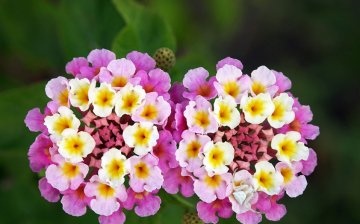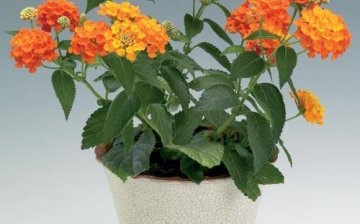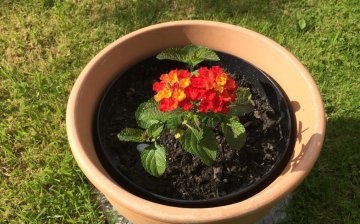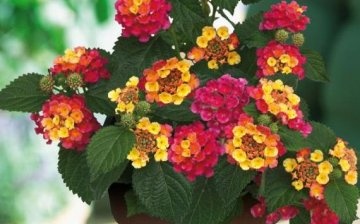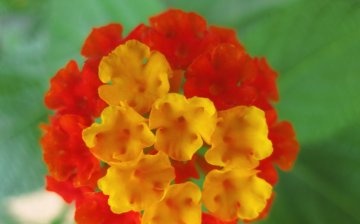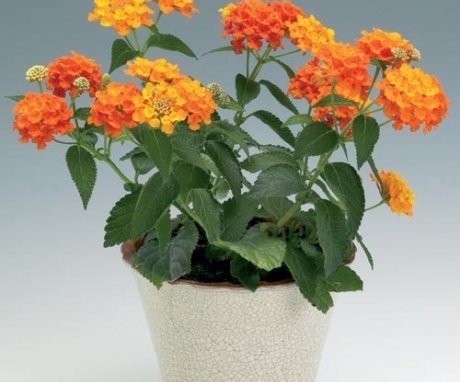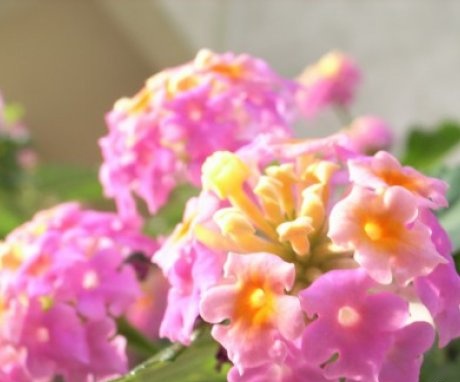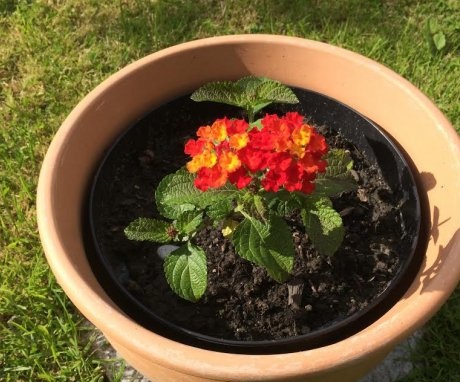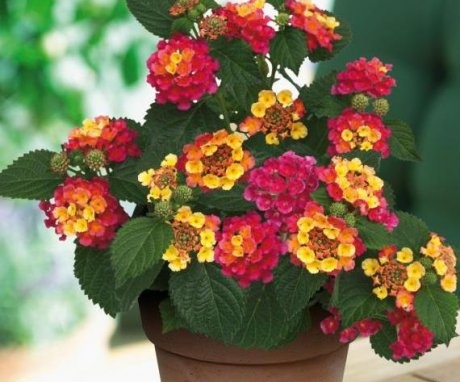Lantana camara - tropical beauty on the windowsill
The Spaniards could not resist bringing lantana camara to their homeland from the America they discovered, but in India and Australia they hate her for her aggressiveness, thanks to which she destroyed all the plants in order to take possession of new spaces.
Universal plant of the Verbenov family lantana camara will not leave anyone indifferent: the colors of her flower umbrellas are so original, the leaves smell so tart! It can grow in open ground, but in warm and humid regions of the world, and the inhabitants of the middle lane admire the flowering bushes on the windows and balconies.
Content:
- Description of a tropical plant
- Conditions for growing lantana kamara
- Flower reproduction methods, planting
- Plant care recommendations
- Diseases, pests of lantana camara
Description of a tropical plant
Lantana camara is the most famous type of tropical plant, which has a thorny tetrahedral stem on which dark green heart-shaped leaves are located, similar in structure to nettles. Above, their surface is slightly rough, and slightly pubescent on the underside. For the leaf plate, a serrated edge is characteristic, a clear expression of veins. The leaves exude a strong tart aroma, reminiscent of the smell of camphor, mintmixed with onions.
From May to September, lantana is covered with small flowers, collected in apical globular inflorescences, the color of which changes as it blooms, for example, from cream to yellow, and then it changes to red. Within three days, each flower undergoes a change in color, so that on one stem they can be in three different colors. It is not for nothing that the Czechs call the plant "a girl's word".
Selected varieties of lantana have species with uniform flowers that do not change color.
After the camara has faded, fruits appear on it in the form of berries, in an immature form, quite poisonous for both humans and animals. The external attractiveness of the plant during flowering allows him to win the hearts of many flower growers who want to breed a beauty at home and in the garden.
Conditions for growing lantana kamara
In order for lantana camara to grow successfully on a windowsill, it needs to create conditions that are inherent in a plant in natural conditions, in the tropics. In the forests of Brazil, the plant reaches a height of about two meters and forms impenetrable thickets, like weed.
The favorite places for the growth of bushes are bright meadows, sunny edges, river banks. In summer, the flower enjoys a high temperature of about thirty degrees and high humidity. In the winter months, a well-lit windowsill in a cool room with moderately humid air, no higher than ten degrees above zero, is suitable for keeping lantana.
In case of heat in houses in autumn, the plant can shed its leaves, then until the beginning of March it can be placed in a dark place, occasionally watering.
After a dormant period, the bush is cut off, transplanted in another pot, choosing a warm, sufficiently lit place for it. The soil for lantana is prepared taking into account the fact that it blooms poorly in too fertile soil.A pot for a houseplant is filled with leaf humus, mixed half with sand.
Thus, a tropical flower, when creating conditions close to natural for it, will decorate the premises of the house, loggias, balconies for a long time.
Flower reproduction methods, planting
Houseplant propagated cuttings and seeds.
Lantana cuttings:
- For vegetative propagation, semi-lignified cuttings with a ten centimeter heel are prepared from February to March, when pruning of the mother plant begins.
- After removing the lower leaves, they are placed in containers filled with loose soil with sufficient moisture.
- For quick rooting, it is necessary to create greenhouse conditions for the planted branches using a film or a cut plastic bottle.
- The first month the material should be in twenty degrees of heat, then it is lowered to twelve.
- After the appearance of the first shoots, the side branches are pinched, giving the desired shape to the future bush.
For some varieties of lantana camara, cultivation from seeds is characteristic, which can be purchased in specialized stores:
- Before boarding the seeds steamed in a thermos for two hours, then put in a solution of a growth stimulator.
- After preliminary germination sown in the ground, covering the top with a film.
- Leaves can appear only after a month, subject to increased heat and humidity.
- Dive the plant no earlier than four leaves appear on them.
In warm summer, lantana can be planted in flower beds, but you need to know that it can destroy its neighbors, so it is better to place plants that bloom in different shades on a flower bed or decorate with them lawns... But in this case, the bushes at the end of summer will shed their foliage, they may cease to exist. Having landed it in a tub, it is necessary to cut the flower and bring it to a cold place.
Plant care recommendations
The unpretentiousness of the plant is known, but it needs care and attention in the same way as other indoor flowers:
- During the flowering period of lantana, camara requires abundant glaze, but without excess. As soon as the top layer dries one or two centimeters deep, watering is required. During the rest period, it is limited.
- The plant loves showering, which is necessary to wash off dust from leaves and flowers.
- Before the start of active growth, the flower is cut off, subjecting the old, lateral branches to this procedure. Pruning should be carried out in order to update the plant, to give the bush a shape. It can be a spherical plant, a standard tree, an ampelous flower.
- In the summer, lantana is fed with a complex fertilizerdesigned for flowering indoor plants. Sometimes infusion of mullein is added to the ground in small quantities, otherwise all the beauty will go into lush greenery without flowering. No additional feeding is needed in winter.
- Annual spring transfer shortening the long roots into a wider container is required for the plant.
The rules for caring for lantana are simple and do not require any costs.
Diseases and pests of lantana camara
Diseases caused by different types of fungi are also found in tropical beauty with improper care of her. Parts of the plant are affected by wilting, rust, spotting, and rot. In these cases, spraying will help to cope with diseases fungicidal solutions and traditional medicine:
- Infusion based marigolds, prepared from one hundred grams of dried flowers, filled with a liter of boiling water, left for two days, is used for medicinal spraying.
- Head garlic cleaned, rubbed, poured with a liter of water. After a week of infusion, filter the product, add a quarter of a glass of garlic medicine to a bucket of water. Spraying with a solution will help fight spotting, rust on an indoor flower.
- For the prevention of fungal diseases, watering with a weak solution of furacilin or potassium permanganate is recommended.
Of the pests, the whitefly, a flying insect resembling a harmless moth, most often attacks lantana. On the inner side of the leaf, the pest lays about two hundred eggs, and during wet summer, the parasite's offspring appear more than ten times, which feeds on the juices of the affected plant.
You can kill an adult insect with glue traps, and it is best to remove leaves with larvae.
The rest of the plant is washed with a solution of laundry soap, which is then washed off. Of the chemicals, Fitoferm will help, effective even in small doses, and does not cause burns.
In rare cases, an indoor flower is attacked aphid, spider mite, you can fight them using similar methods. By creating comfortable conditions for the plant, you can be calm about its health.
Under the mysterious name of the flower - lantana camara - there is a beautiful plant blooming in bright colors that grows in warm regions, but can bring joy, blooming in an apartment on the windowsills. It has its own characteristics of cultivation, leaving, the observance of which will allow him to bloom all year round.
More information can be found in the video:



